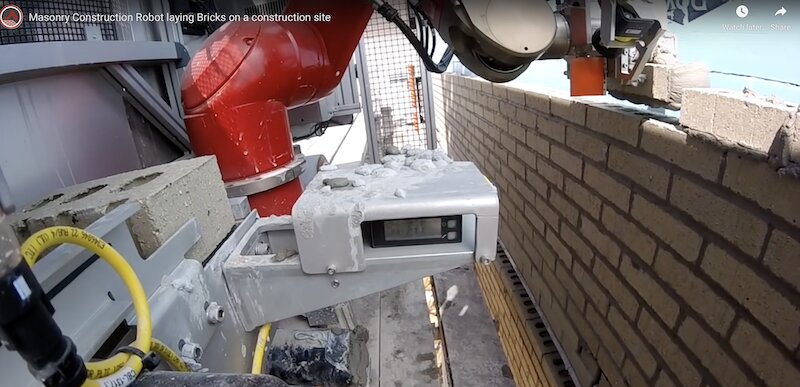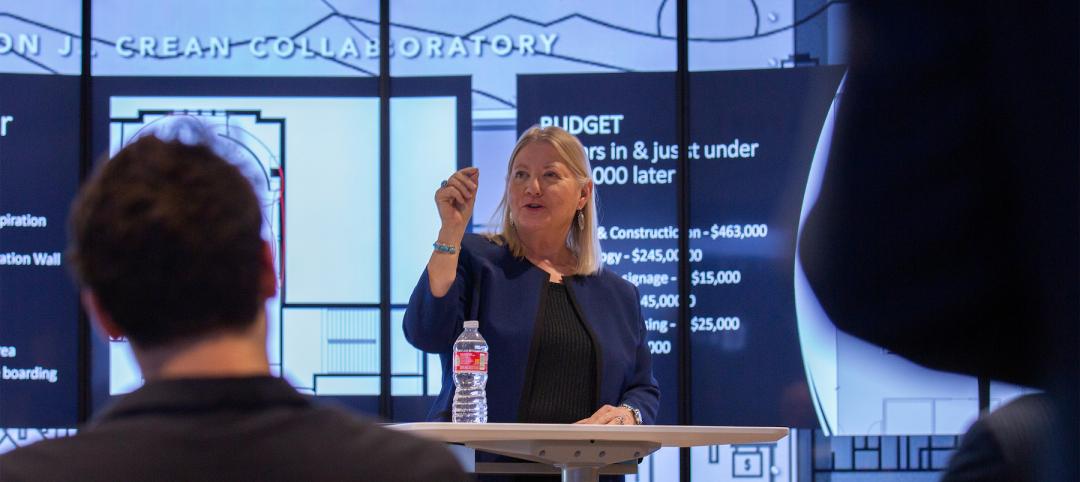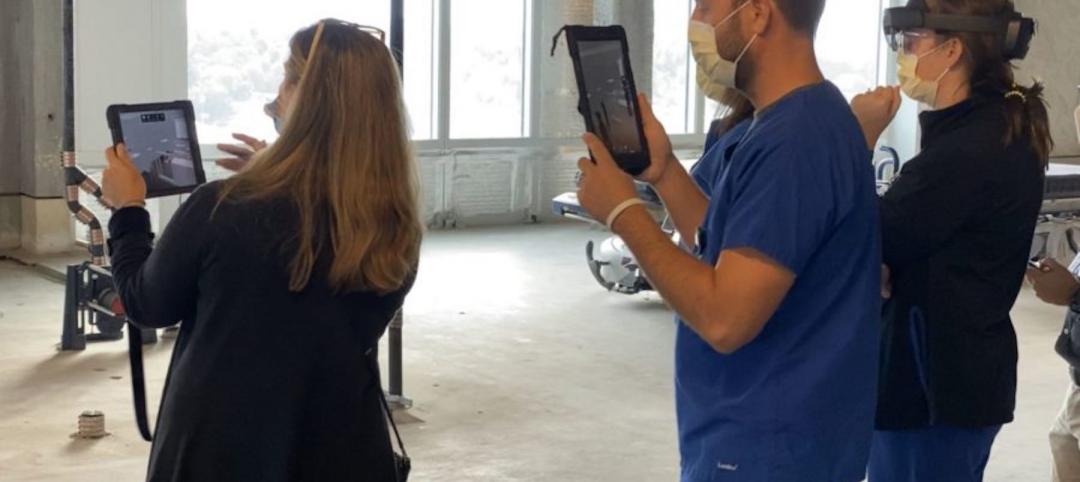A 166,000-sf barracks with 300 bedrooms for 600 military personnel is under construction at the Great Lakes Naval Base in Illinois with the help of robots that can lay bricks every seven to 10 seconds and can lift and place foundation blocks weighing up to 135 lbs.
This $52 million project, started last March and scheduled for completion in October 2020, represents the debut of semi-robotic construction for the general contractor Clark Construction Group. Construction Robotics, a Victor, N.Y.-based manufacturer that launched in 2007, is providing the machines, which are called MULE (for Material Unit Lift Enhancer) and SAM (for Semiautomated Mason). Blinderman Constuction is Clark's partner on this project.
This is also the first construction project in the country to use MULE and SAM technology in tandem.
There are currently more than 130 MULEs operating in the field, and 11 SAMs, with more under production, says Scott Peters, president and cofounder of Construction Robotics. His company has worked with more than 80 contractors, from large GCs like Barton Malow and Wilhelm Construction, to local masonry subcontractors like Leidal & Hart Mason Contractors in Michigan and Jimmy ‘Z Masonry in Crystal Lake, Ill., the latter of which is working on the abovementioned barracks project, and reportedly advocated for the use of robots.

The SAM robot can lay brick at a pace of one every 7-10 seconds.
Construction Robotics’ machines have installed more than one million sf of wall, says Peters, whose training is in engineering. His partner, Nate Podkaminer, has a background in architecture and construction.
Tyler Shawcross, Clark’s senior project manager, says that his company first met with Construction Robotics’ principals about five years ago. “Our R&D team is always looking for ways to build smarter,” he says.
When asked how this technology benefits masons at a time when workers are losing their jobs to automation in many industries, Shawcross notes that masonry, like many other construction trades, is suffering from labor shortages and an aging workforce. Plus, he adds, these trades simply are not attracting younger workers.
Construction Robotics has had a training program for masons in place since 2018. Both Peters and Shawcross agree that the technology not only has the potential for extending the work longevity of masons, but also might entice younger workers to consider entering the profession.
MULEs cost between $70,000 to $80,000 to purchase and are relatively simple to operate. For the barracks project, the MULE grabs the 32-inch blocks (which Oldcastle developed specifically for this job). The mason positions the hoisted block onto the foundation row. “It’s like an extension of your hand,” says Shawcross.
SAMs are more complicated machines that require three-to-five days of training to operate. The machines are generally leased by the week, month, or longer. Peters is reluctant to discuss pricing because, he explains, each project is different and requires customized software coding. (Peters notes that SAMs can be programmed to lay bricks in complex patterns and color sequences.)
To view videos of MULE and SAM in action, click here.
Construction Robotics claims SAMs reduce labor costs by at least 30%. Shawcross couldn’t quantify the time and cost savings from using the robots. He notes, though, that the machines provide a reliable production rate. “We see it as an opportunity to drive cost certainty into a project. I don’t think it’s a large cost reducer, but it could be a scheduling reducer.”
Peters says that robotics are most effective in construction when they are factored into the building process early in the planning stage. “That’s why we engage with GCs like Clark.” He concedes, however, that the construction industry in general is slow to change. “Companies need to think about new technology, and use their money to learn.”
Shawcross believes that robotics will become more prevalent on jobsites for performing repetitive tasks. Peters says that on another project, a MULE was used to move concrete form panels into place. “It’s one of those rare products that provides both speed and safety,” he says.
Related Stories
AEC Tech | Sep 23, 2022
Register today! Live webinar: 10 KPIs your AE firm needs to track for maximum project profitability
Join us for an engaging, live webinar presented by Steven Burns, FAIA, Chief Creative Officer at BQE Software as he explores 10 project performance KPIs that, when tracked properly, will transform the way your business operates, and subsequently how profitable each project is.
AEC Tech | Sep 15, 2022
Register today! Live webinar: Minimize project expenses to stay on budget with 360° photo capture
Learn how reality capture technology like 360° photo capture allows your on-site team to document jobsites faster and more accurately than ever. This live webinar will take place September 20, 2022, at 2 ET / 1 CT.
AEC Tech | Aug 8, 2022
The technology balancing act
As our world reopens from COVID isolation, we are entering back into undefined territory – a form of hybrid existence.
Security and Life Safety | Jul 5, 2022
What AEC firms should look for in a cybersecurity partner
When looking for expert partners in cybersecurity, AEC firms will find quite a lot of companies claiming to be at the forefront of modern threats. Here are five key points to look for when choosing a cybersecurity firm.
Laboratories | Jun 29, 2022
The "collaboratory" brings digital innovation to the classroom
The Collaboratory—a mix of collaboration and laboratory—is a networking center being designed at the University of Denver’s College of Business.
Augmented Reality | Jun 22, 2022
Not just for POKÉMON GO anymore: how augmented reality is transforming architecture
By solving a long-standing communication problem, Augmented Reality (AR) is poised to make architecture quicker, nimbler, and more cost effective.
Healthcare Facilities | Jun 20, 2022
Is telehealth finally mainstream?
After more than a century of development, telehealth has become a standard alternative for many types of care.
Smart Buildings | Jun 1, 2022
Taking full advantage of smart building technology
Drew Deatherage of Crux Solutions discusses where owners and AEC firms could do better at optimizing smart technology in building design and operations.
BAS and Security | May 26, 2022
Can your intelligent building outsmart hackers?
ESD's security services studio leader Coleman Wolf offers tips, advice, and lessons for protecting real estate assets from cyberattacks.
Architects | Apr 26, 2022
Low-tech skills architects need to keep in a high-tech world
As architects continue to lean into learning and mastering the latest technologies, let us not forget the foundational, fundamental skills that are still expected by clients. RS&H National Design Director Philip Robbie explains.
















